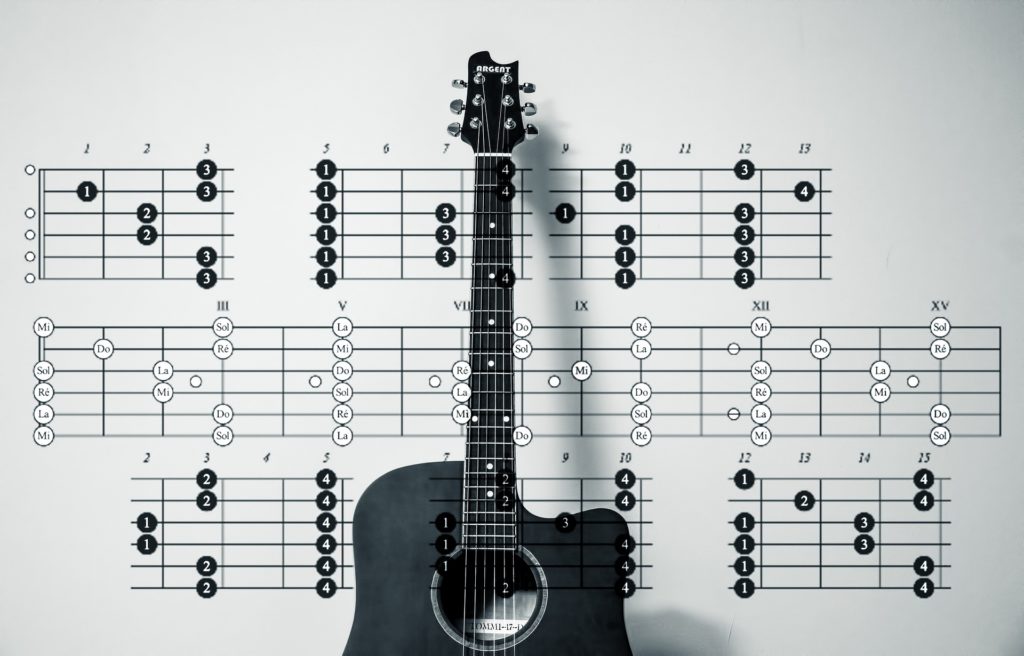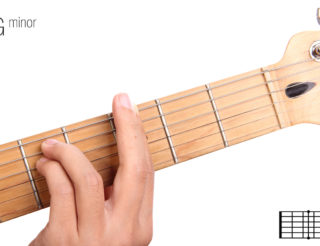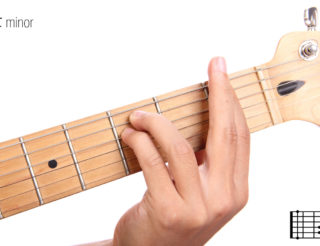Introduction to Scales and Chords for Guitar
Author: Wanda Waterman

This article aims to give you a little background into how scales and chords work together. We hope this post helps you in becoming a better guitar player.
(If you’d like to get a more secure feel for the theory behind the practice of music making, the Uberchord blog has a helpful set of music theory articles listed at the end of this article.)
Table of Contents
The Interval Pattern of the Major Scale
The series of tone intervals in a major scale goes like this:
whole tone, whole tone, half tone, whole tone, whole tone, whole tone, half-tone
In other words, at the third and the seventh positions in the scale there’s a halftone, and between all the other notes there are whole tones. All major keys follow this pattern, so if you ever want to figure out the accidentals for yourself, just start with the root note and count off the above pattern.
This means that the scale of the key of C major, for example, is made up of C, D, E, F, G, A, and B.
The Interval Pattern of the Minor Scale
Now let’s take a quick look at the differences between a major scale and a minor scale.
Unlike major keys, the tones in a minor key arrive in this sequence:
whole tone, half tone, whole tone, whole tone, half-tone, whole tone, whole tone
In other words, the second and the fifth positions on the scale are just half tones above their preceding notes, and all the other notes are whole tones above their previous notes. All natural minor keys follow this same pattern.
 Chords and Chord Progressions
Chords and Chord Progressions
It’s very important to distinguish between the interval pattern in a scale and the series of chords built on each of those intervals.
Major Key Chord Progressions
For example, the C major chord, which forms the root of the C major scale, is made up of the notes C, E, and G— the first, third, and fifth notes of the key of C major.
If you were to use every chord in the key of C major, the following would be the chords you’d use:
I. C
II. D minor
III. E minor
IV. F
V. G
VI. A minor
VII. B diminished
Why are the D, E, and A chords minor? Because in the major scale the chords at the second, third, and sixth positions of the key are minor.
Why is the B a diminished chord? Because in the key of C major it sits in the seventh place, and in major keys all seventh place chords are diminished.
Minor Key Chord Progressions
To complicate things a little, not only are the sequences of tones different in minor keys, which chords are major and minor is also different than the pattern used in major keys. In minor keys the sequence is as follows:
I. minor
II. diminished
III. major
IV. minor
V. minor
VI. major
VII. major
For example, the C minor chord, which forms the root of the C minor scale, is made up of the notes C, Eb, and G— the first, third, and fifth notes of the key of C Minor.
Why does this chord sound so different from the C major chord? The only difference is one string; in the C minor chord the E becomes Eb (because that’s what C minor’s key signature dictates), and that’s all it takes to turn a cheerful C major chord into a melancholy C minor.
Seventh Chords
For variety and greater expressiveness, the V chord in every scale, major or minor, can also be played as a V7, which just means adding the seventh note of the V chord’s key to the chord.
The V chord has the honor of being the chord that announces the ending of the musical phrase. Adding the seventh note of the key of G (F) to the G chord, creating a G7, makes the G chord sounds a little more like it’s leading back to the root chord (C) that usually comes next, or, in cases where no chord comes next, gives the musical phrase an unresolved sound.
(If you want to better understand 7th chords and how to use them, check out this article on our blog.)
Progressions in General (For Both Major and Minor Keys)
 Your practice sessions, after you’ve learned your chord shapes and how to play them, are made up of chord progressons. The songs you hear are made up of chord progressions. When you look up the chords to a song, you’re looking for that song’s chord progressions. The chord progressions must include the notes of the song’s melody and harmony as they move along, but they also have to sound good all by themselves.
Your practice sessions, after you’ve learned your chord shapes and how to play them, are made up of chord progressons. The songs you hear are made up of chord progressions. When you look up the chords to a song, you’re looking for that song’s chord progressions. The chord progressions must include the notes of the song’s melody and harmony as they move along, but they also have to sound good all by themselves.
By far the most common chord progression for folk, classical, jazz standards, country, and pop songs is loosely this: I, IV, V, I (that is, on the first, fourth, and fifth chords in each key, major or minor).
The following are a few more chord progressions. Most of the songs you hear are composed of different combinations of these chord progressions. In addition to your Uberchord lessons, take a little time to play around with the progressions below to become more familiar with how these chords, depending on their order and context, create a sense of beginning, rising, falling, and ending.
- I—IV—V—I
- I – V – VI – IV
- I – VI—IV – V
- I – V – VI – III – IV – I – IV – V
- (Blues) I – I – I – I – IV – IV – I – I – V – V – I – I
- II – IV – V
- I – IV – V – IV
- V – IV – I
- VI – IV – I – V
Enharmonic Equivalents
Do you ever wonder why some keys have two names and two possible key signatures, even if they sound exactly the same? It’s because of a concept called enharmonic equivalents. This is a term used to describe two keys that sound exactly the same but that have different names and different key signatures.
It’s simpler than it looks. You probably already know, for example, that there’s only one note— a half-tone— between D and E and that this note can be called either D# or Eb, depending on which key you’re in.
It’s the same for keys: The same key can be called D# or Eb, depending on the composer’s choice of notation.
Most composers and songwriters prefer to use the notation with the least number of accidentals (for one thing, it keeps the musicians from griping), which explains why most composers notate this key as E flat as opposed to D sharp: D sharp has six accidentals (sharps) whereas the key of E flat has only three accidentals— three flats.
The same concept is also true for chords. F# and Gb are the same chords on your guitar. So are C# and Db.
Want to know more? The Uberchord blog has lots more information for you to explore:
Chord Progressions in Rock Music
Find and Memorise the Notes on the Guitar Fretboard Like a Pro
Chord Progressions – How To Make Simple Chords Interesting
Chord Progressions in Minor Keys
How to get Creative with Chord Inversions
A few other topics we’ve published lately that you may enjoy learning include what key is equivalent to b flat minor, 1-7 progression, and a review of the meludia app.









No comments yet - be the first.